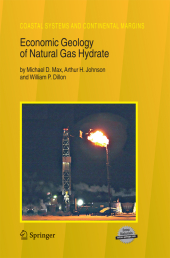 Neuerscheinungen 2014Stand: 2020-02-01 |
Schnellsuche
ISBN/Stichwort/Autor
|
Herderstra▀e 10
10625 Berlin
Tel.: 030 315 714 16
Fax 030 315 714 14
info@buchspektrum.de |

William P. Dillon, Arthur H. Johnson, Michael D. Max
(Beteiligte)
Economic Geology of Natural Gas Hydrate
2006. 2014. xxi, 343 S. 235 mm
Verlag/Jahr: SPRINGER NETHERLANDS; SPRINGER 2014
ISBN: 9400788509 (9400788509)
Neue ISBN: 978-9400788503 (9789400788503)
Preis und Lieferzeit: Bitte klicken
This book is a companion to "Natural Gas Hydrate in Oceanic and Permafrost Environments" (Max, 2000, 2003), which is the first book on gas hydrate in this series. Although other gases can naturally form clathrate hydrates (referred to after as ┤hydrate┤), we are concerned here only with hydrocarbon gases that form hydrates. The most important of these natural gases is methane. Whereas the first book is a general introduction to the subject of natural gas hydrate, this book focuses on the geology and geochemical controls of gas hydrate development and on gas extraction from naturally occurring hydrocarbon hydrates. This is the first broad treatment of gas hydrate as a natural resource within an economic geological framework. This book is written mainly to stand alone for brevity and to minimize duplication. Information in Max (2000; 2003) should also be consulted for completeness. Hydrate is a type of clathrate (Sloan, 1998) that is formed from a cage structure of water molecules in which gas molecules occupying void sites within the cages stabilize the structure through van der Waals or hydrogen bonding.
Why Gas Hydrate?.- Physical Chemical Characteristics of Natural Gas Hydrate.- Oceanic Gas Hydrate Character, Distribution, and Potential for Concentration.- Natural Gas Hydrate: A Diagenetic Economic Mineral Resource.- State of Development of Gas Hydrate as an Economic Resource.- Oceanic Gas Hydrate Localization, Exploration, and Extraction.- Gas Production from Unconfined Class 2 Oceanic Hydrate Accumulations.- Regulatory and Permitting Environment for Gas Hydrate.- Conclusions and Summary.


